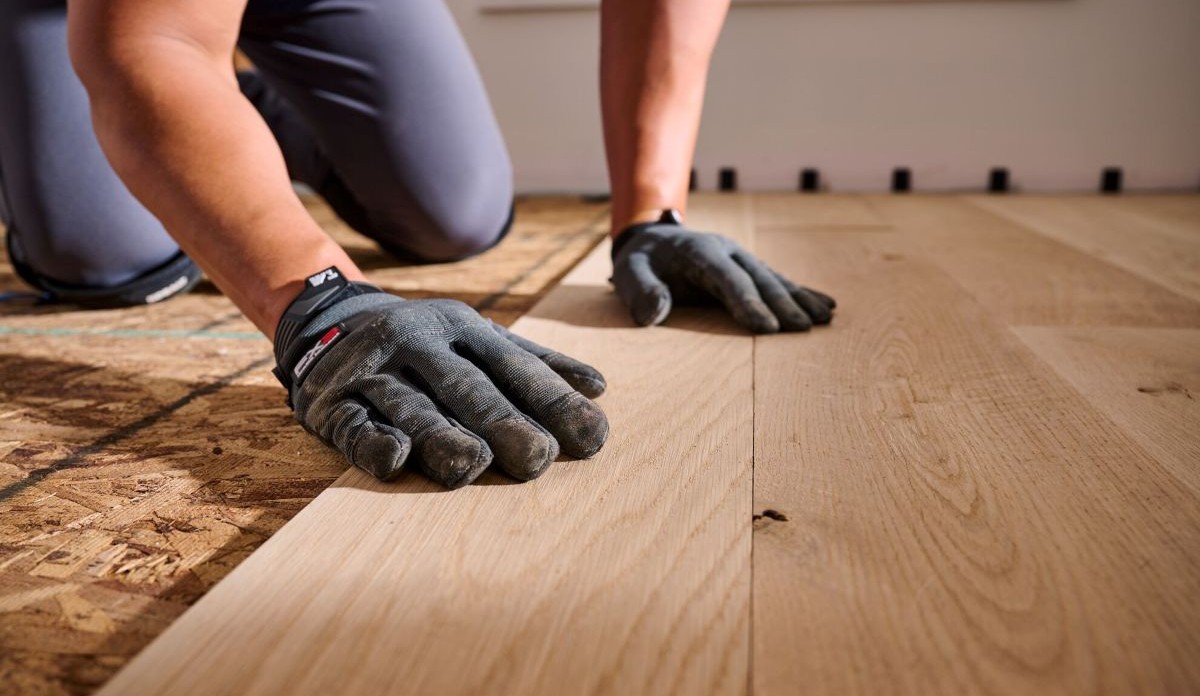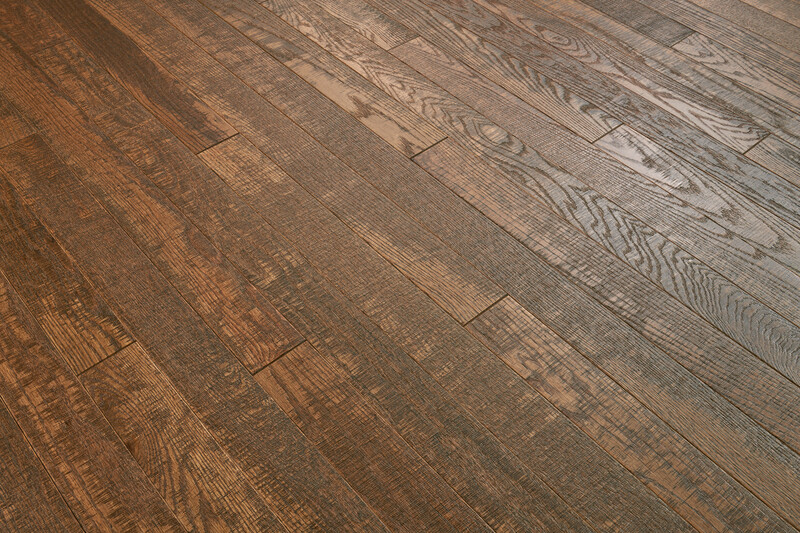Hardwood Flooring Checklist – Be Ready Before You Buy
By Bruce Flooring Expert, Published August 22, 2025
You’ve spent countless hours reviewing various flooring types, from carpeting and luxury vinyl plank to laminate and hardwood, and you’ve finally decided. You want the timeless character of hardwood flooring. Now comes the next step—choosing those hardwood floors.
First, you need to consider your home’s style. Your hardwood floors should match your cabinetry, furniture, and color schemes. Beyond that, you must consider risking the latest flooring trends or sticking with something more traditional and safe.
But be careful, as your decision could affect your resale.
Many details can be covered once you have the big picture out of the way. So, here’s a checklist to help when choosing hardwood floors.

🗹 What’s Your Budget?
Solid hardwood flooring costs more than engineered hardwood. So, if your budget is limited, you can still get hardwood floors, but you may want to opt for engineered flooring.
You’ll also want to purchase at least 10% more flooring than you need. Although it may seem like extra costs, that extra flooring will be a plus if the installer damages some hardwood during installation.
🗹 Who Will Install Your Hardwood Floors?
If you’re the handy type and don’t mind biting off a DIY project, you can save a great deal on hardwood installation. However, you’ll need to ensure you have the right tools and instructions for installing the flooring.
DIY tip: If you’re into DIY installation, engineered hardwood may present a less imposing installation than hardwood flooring because you can float your floors.
The safer route may be to hire a professional installer, albeit with additional costs you’ll need to account for.
🗹 Where Will You Install Your Hardwood Floors?
The location of your hardwood flooring helps determine what hardwood to select. Is the room above or below grade? Below-grade calls for engineered flooring.
What about traffic patterns? For example, in higher-traffic areas, you’ll want to consider harder wood species like oak, maple, hickory, or walnut. You can get a better feel for the hardness of a species by looking at its Janka Rating, which determines how dense a wood species is and how resistant it will be to wear.
For instance, oak flooring has a rating of 1360, making it one of the more durable hardwood flooring choices. It’s an excellent selection for dining rooms, entries, and family rooms where you can expect more wear and tear on your floors.
🗹 Does the Space Have Moisture Concerns?
Apart from traffic, you’ll also want to consider any moisture concerns with the room. Kitchens, bathrooms, and basements present water issues. Unfortunately, water and hardwoods don’t mix. Even humidity causes wood floors to expand and contract, leading to warping. If the room faces moisture issues, consider engineered hardwood that is more resistant to water damage than solid hardwood flooring.
🗹 How Much Light Does the Room Get?
You may not think this is a concern, but extended sunlight exposure discolors light-sensitive hardwoods like walnut, teak, and cherry. Even maple and hickory show some mild light sensitivity. That doesn’t mean you shouldn’t use these species.
It calls for some precautions, like periodically moving furniture and rugs to allow a similar light pattern on the floor. You may also want to use an area rug where your hardwood receives substantial sunlight.
You can also look for UV-coated wood flooring to protect your floors.
🗹 What’s Your Subfloor?
Do you have a plywood subfloor? Is it concrete?
Your subflooring substantially impacts your choice of hardwood floors, as it determines your installation method and whether you’ll use nails, glue, or even float your wood flooring.
Concrete subfloors require glue or a floating installation. And that means engineered hardwood. Plywood subfloors allow for engineered or solid hardwood flooring. However, hardwood flooring is likely the better choice. Hardwood flooring will serve you longer because you’ll have the option of refinishing it multiple times.
🗹 Do You Have Any Height Constraints?
You’ll want to consider height constraints in conjunction with the subflooring.
For instance, check your door heights, steps, cabinetry, and appliances. Hardwood flooring is ¾” thick versus engineered hardwood, ranging from 3/8” to ½” thick. Due to its thinner profile, you might need to go with engineered hardwood if you lack appropriate clearances.
🗹 Are There Any Other Installation Concerns?
Before installing hardwood flooring, consider whether you want a sound barrier underlayment to reduce noise.
You’ll also need to consider your heating source, as it impacts your choice of hardwood floors. Some woods won’t work with radiant heat. For example, you’ll want to use rifted and quarter-sawn oak flooring with radiant heat.
🗹 Is Hardwood or Engineered Hardwood Better?
We mentioned some instances where engineered hardwood is the better option, notably in moisture-prone areas.
Your room location, budget, subflooring, and other determinants dictate which wood flooring option is best.

🗹 Prefinished or On-Site Finishing?
Prefinished hardwood flooring offers several advantages. First, you can install it faster than unfinished flooring because no sanding and finishing are required.
Second, hardwood flooring manufacturers apply an aluminum oxide finish, which increases the floor’s durability. So, if you have kids or pets, you might prefer prefinished wood flooring.
Third, you’ll avoid the mess and unpleasant odors of finishing your hardwood floors after installation.
However, unfinished hardwood flooring has smoother edges, so it looks more natural. It also has a more consistent color, which makes it easier to match your hardwood color with flooring in other areas of your house.
Site-finished hardwood flooring is more impervious to water, which is a plus if you want to use it in a kitchen. And finally, you can test colors and create customized colors.
🗹 What Color Scheme Do You Want?
What color will work best in your room, and what shade? What colors do you like?
Some considerations include your cabinets. Tip: Contrasting your hardwood floors with your cabinets is best.
In addition, you’ll want to consider the room’s lighting and size. For example, darker-colored hardwood floors like walnut work best with more lighting. The downside is that dark wood floors show scratches more readily.
Lighter-colored hardwoods like maple brighten a room and hide scratches. At the same time, you’ll have less of a need to break out your broom or cover marks and scrapes.
Get insights on how to choose a hardwood flooring color.
🗹 What About the Finish?
You can accentuate your color selection with different sheens, including matte, satin, semi-gloss, and glossy. Each hardwood produces different sheen levels based on the wood’s porosity. The more glossy your hardwood floors, the more light they’ll reflect. But keep in mind that the added gloss also shows imperfections and dust.
Tip: Today, satin finishes are the most popular. They give your room a classic look and show fewer scratches and imperfections. So, if you’re not into cleaning your hardwood floors constantly, you might want to consider a lower-gloss finish.
🗹 What Type of Grain Do You Prefer?
Each hardwood species has unique grain patterns and colors. So, you can select wood flooring with a tight or open grain. Here are some examples:
Oak has a moderate to heavy, tight grain. If you use a light stain, that grain becomes accentuated. White oak is beige to dark brown, whereas red oak has pink undertones.
Hickory graining is usually straight but with some waves. It also includes “bird pecks” and mineral streak forms. Its grain is unique and adds substantial character to your floors. Hickory presents brown and reddish-brown tones.
Maple’s grain is generally more open and straight, but it can present some variations. Its colors range from nearly white to an off-white cream color.
🗹 What Grade Does Your Project Require?
Wood gets graded as select, natural, and rustic. So, you’ll need to consider the grade when choosing hardwood floors. The grade impacts quality. In addition, lower-grade wood floors typically have more knots than prime-grade hardwood floors. Learn more about hardwood floor grades.
🗹 How Wide Do You Want the Floor’s Planks?
Traditional wood flooring uses 2-1/4” to 3-inch wide planks, which create clean, consistent lines. However, wider plank flooring is in vogue, with widths ranging from three to seven inches. Some floors even feature 24-inch-wide planks, though most manufacturers stop at 12 inches or less.
Plank width plays a significant role, depending on your room size. For smaller rooms, it’s best to use narrower planks with light-colored wood, which makes the space seem more significant.
In addition, narrow plank floors don’t shift as much as wide plank floors when exposed to humidity. So, they’re less prone to warpage and buckling.
With larger rooms, you have greater leeway with plank widths. Wide plank hardwood floors add a rustic flavor to a room. They also show more of the wood’s grain and natural imperfections. \Wide planks and lighter wood create a more open look in modern spaces. You’ll also see fewer seams between boards and fewer interruptions of natural lines.
Check out this guide on choosing the best hardwood floor width.

🗹 What About Texture?
Texture impacts how your floor feels when you walk on it and significantly affects its appearance.
Many homeowners prefer a traditional look with a smooth texture. Typically, it creates a uniform, clean look in a room. However, today’s hardwood flooring offers more versatility regarding surfaces.
For example, now you can select from distressed, hand-scraped, wire-brushed, reclaimed, and even barn wood textures. These heavily textured hardwood floors look more authentic than smooth wood.
In addition, they give you some relief from damaging your hardwood floors. The natural indentations and imperfections add a worn look, making any new blemishes less obvious, but the look and feel are much more rustic.
🗹 Do You Have Kids and Pets?
Do you have active children running around your house? Or do you have a dog whose nails can wreak havoc on wood flooring?
If your household involves one or both scenarios, selecting a hardwood floor that withstands punishment is essential. Start by choosing a hardwood with a high Janka rating – oak, hickory, or maple. Then you can layer in texture.
If you have even more extensive concerns, you can now select hardwood flooring made from hardened, densified wood. For example, Dogwood®, a densified wood flooring, uses a patent-pending process that creates hardened timber, making it highly resistant to scratches, gouges, and dents.
🗹 What Length of Warranty Do You Want?
The most common warranty for residential wood flooring is 25 years. However, some manufacturers offer even more extended warranties. For example, Bruce® offers a 50-year residential limited warranty with America’s Best Choice solid hardwood flooring.
Use This Checklist When Choosing Hardwood Floors
As you can see, you have to check many boxes when choosing hardwood flooring. But taking the time to do so ensures your floors can last your lifetime. So, your time investment will be well worth it.
Here’s one last consideration. You might want to purchase one box of the hardwood flooring you choose, take it home, and see how it looks when you lay it out. That way, you’ll be sure your selection won’t surprise you.
Good luck shopping! And remember, America was built on Bruce® floors. We’ve been providing wood flooring solutions to homeowners since 1884. And we’re still the flooring of choice for many homeowners across the country. Find the Bruce retailer nearest you.
